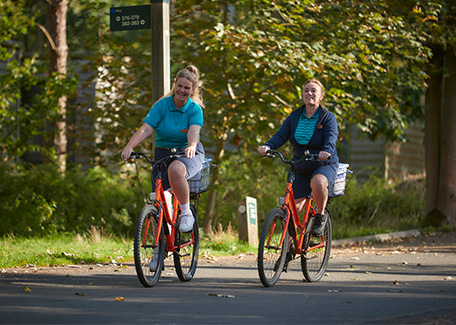Sherwood Forest, Nottinghamshire
Arguably the most famous of our forests, Sherwood Forest is synonymous with the legend of Robin Hood, with the famous Major Oak still standing tall just a few miles away.
The area was also used as a Royal hunting forest from the 11th century and records show that at one time the forest covered around a fifth of the county (around 100,000 acres). It was a mixture of woodland pasture, heathland and acid grassland, and a number of these mature oaks can still be seen today within the forest.

Securing the forest’s future
The woodland was owned by the Forestry Commission and was identified as a site for a Center Parcs village due to its location in the heart of the country, as well as the age structure of the forest. The 400 acre site acquired was described as a ‘typical dark and dank commercial coniferous plantation’, known as Pittance Park. Commercial plantations are created to provide a regular supply of timber, and a woodland of this type would typically be felled every 50-70 years, meaning we gave these trees a chance to mature and develop. This particular area of woodland was planted after the Second World War on the parkland surrounding Rufford Abbey, and primarily consisted of Scots and Corsican pine - these trees were used as ‘pit props’ in local mines and so this woodland supported the mining heritage of the area.

Letting the light in
In 1987, hurricane-force winds hit the UK, recording wind speeds of up to 120mph. As a result, a number of trees were damaged and destroyed, leading to large areas of the forest being opened up. Combined with the areas of the forest which were thinned during construction of the village, this created fantastic opportunities for biodiversity, as dormant seed banks began to flourish and habitats began to recover and regenerate. Within a few years, the woodland boasted an array of reptiles (relishing the increased sunlight reaching the forest floor), whilst bees and wasps flocked to the rare heathland.
We also added a number of man-made water systems comprising of small streams to feed the main lake in the centre of the village. These remain important habits for invertebrate species.

From commercial plantation to thriving ecosystem
The forest today comprises a mixture of scrub, semi-natural neutral grassland, lowland dry acid grassland, and a diverse mix of native species within the understorey and woodland. The glimpses of Scots and Corsican pine are a reminder of the rich history of the forest, and our responsibility to protect and enhance it for future generations. Since 1987, we have planted more than 500,000 trees, carefully nurturing our arboreal inventory and carrying out selective thinning to benefit the forest. Today, Sherwood Forest is home to an abundance of birds, mammals, plants and insects, including those which are considered rare both locally and nationally.




